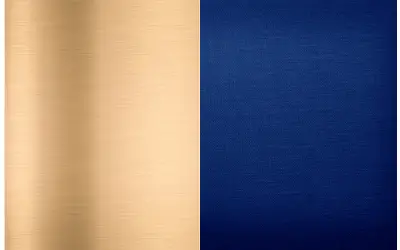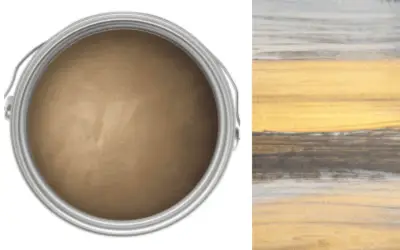Creating bronze effects is one of those fun, creative tasks that always feels rewarding when the project turns out as planned. With just a few simple steps and materials, you can have your own DIY bronze paint in no time.
Today, I will walk you through step-by-step process on how to make bronze paint. Whether it’s for an interior decorating job or crafting masterpiece, you can get the desired result without having to spend money on store bought products.
What Color is Bronze
Bronze is a metallic alloy characterized by a rich, warm color. It exhibits a deep golden hue with reddish-brown undertones. The precise shade of bronze is similar to metal alloy but can vary depending on the specific composition of the alloy, but it generally embodies a lustrous and earthy tone.
This captivating color is often associated with durability, strength, and elegance, making it a popular choice for statues, bronze sculptures, and ornamental accents.
Types of Bronze
There are several types of bronze, each with its own unique properties and applications:
Phosphor Bronze
This type of bronze contains a small amount of phosphorus, which enhances its strength, durability, and resistance to corrosion. Phosphor bronze is commonly used in musical instruments, electrical connectors, and springs.
Aluminum Bronze
By adding aluminium to the alloy, aluminium bronze is formed. It possesses excellent strength, high resistance to corrosion, and good thermal and electrical conductivity. This type of bronze is used in marine applications, such as propellers, valves, and ship fittings.
Silicon Bronze
Silicon bronze is created by adding silicon to the bronze mixture. It has high strength, good resistance to corrosion, and exceptional weldability. Silicon bronze is often employed in architectural applications, such as decorative hardware, sculpture, and jewellery.
Manganese Bronze
Manganese bronze contains significant amounts of manganese. It exhibits excellent mechanical properties, including high strength, toughness, and wear resistance. Manganese bronze is commonly used in gears, bushings, and bearings.
Leaded Bronze
Leaded bronze contains a small percentage of lead, which enhances its machinability and lubricity. This type of bronze is utilized in applications that require low friction, such as bearings, bushings, and thrust washers.
Gunmetal
Gunmetal is a bronze alloy typically consisting of copper, tin, and zinc. It possesses good casting properties, high corrosion resistance, and excellent wear resistance. Gunmetal is frequently employed in the manufacturing of valves, gears, fittings, and ammunition casings.
What Colors Make Bronze

To create a bronze color, a combination of brown, orange, and yellow hues is typically used. Brown provides the base color, while orange and yellow tones add warmth and depth. A touch of red or copper can be added to enhance the reddish-brown undertones often associated with bronze.
By blending these colors in varying proportions, artists and designers can achieve shades that mimic the appearance of bronze, capturing its characteristic metallic and earthy qualities.
How to Mix Acrylic Paints to Create Bronze: Step-by-Step Guide
To mix acrylic paints and create a bronze color, follow these step-by-step instructions:
Step One: Start with a clean canvas or surface. Apply a thin layer of white paint evenly across the area you want to paint in bronze. Once applied, gently wash away some of the paint while still wet, leaving a slightly translucent base.
Step Two: Take brown paint and mix it with the remaining white paint. Gradually add small amounts of brown paint and blend it thoroughly. Adjust the amount of brown paint until you achieve the desired medium brown shade.
Step Three: Mix red paint with the mixture. The red paint will add warmth and depth to the brown, giving it the reddish-brown undertones associated with bronze. Adjust the amount of red paint according to the intensity of color desired.
Bronze Color Code
The bronze color is often associated with different shades of brown and reddish-brown. However, when it comes to specifying colors in digital or design applications, a standardized color code is used.
The most commonly used bronze color code is #CD7F32 in hexadecimal notation. This code represents the RGB (Red, Green, Blue) values for bronze. The code translates to R: 205, G: 127, B: 50 in decimal values.
It helps ensure consistency across different platforms and mediums, allowing designers, artists, and developers to accurately reproduce the bronze color digitally. By using the bronze color code, they can easily incorporate the desired shade into their projects.
| Code | Value | HTML/CSS |
| Hex | CD7F32 | #CD7F32 |
| RGB | 205, 127, 50 | rgb(205, 127, 50) |
| HSL | 30°, 61%, 50% | hsl(30, 61%, 50%) |
| HSV | 30°, 76%, 81% | |
| CMYK | 0, 38, 76, 20 |
Uses of Bronze
Bronze metal can be used in many different applications. It is an incredibly strong, durable, and malleable metal that can be moulded to create various shapes and sizes.
Sculptures and Statues
Bronze is a favored material for creating sculptures and statues due to its durability and malleability. Its rich color and ability to capture fine details make it ideal for artistic expressions that can withstand outdoor conditions.
Jewellery
Bronze serves as a substitute for gold in jewellery making. It offers a similar warm tone and can be crafted into intricate designs. Bronze jewellery provides an affordable option with a rustic and distinctive aesthetic.
Musical Instruments
Bronze is used to produce various musical instruments, such as cymbals and gongs. Its unique tonal qualities produce rich and resonant sounds, adding depth and character to musical performances.
Architectural Features and Interior Design
Bronze finds its place in architectural elements, including door handles, hardware, and decorative accents. Its lustrous appearance brings an elegant touch to buildings and interior spaces, enhancing its aesthetic appeal.
Coinage
Bronze has historically been used in coinage, particularly for lower-value denominations. Its durability and resistance to corrosion make it suitable for circulation in the form of coins, providing a lasting medium of exchange.
The Symbolism of Bronze
Bronze carries several symbolic meanings associated with its characteristics and historical significance.
Quality
Bronze symbolizes quality craftsmanship and enduring strength. Its use in statues, sculptures, and architectural elements represents a commitment to excellence and attention to detail.
Honesty
Bronze embodies honesty and authenticity. Its natural color and ability to develop a unique patina over time reflect the passage of time and the true nature of the material, symbolizing transparency and sincerity.
Low value
In some contexts, bronze symbolizes low value or lesser worth than precious metals like gold or silver. This symbolism arises from its historical use in coinage for lower denominations, signifying humbleness or simplicity.
Industrious
Bronze represents industriousness and hard work. Its historical use in tools, weapons, and machinery illustrates the importance of labor and craftsmanship in human progress, symbolizing dedication and productivity.
Sensitive
Bronze’s sensitivity to environmental factors, such as oxidation and patina development, symbolizes sensitivity to change and the passage of time. It serves as a reminder of the impermanence of material things and the need to embrace transformation and growth.
Relationship Between Bronze and Individual Personality
The relationship between bronze and individual personality unveils a fascinating connection between symbolic representations and personal traits.
Naturally occurring shade
The relationship between bronze and individual personality can be explored through various traits and characteristics:
Friendly
Individuals associated with bronze may exhibit a friendly and approachable demeanour. Bronze’s warm and inviting color resonates with a welcoming and sociable nature, creating an aura of friendliness and openness.
Sincere
Bronze is often linked to sincerity and authenticity. Individuals connected to bronze may possess genuine and honest personalities, valuing truthfulness and transparency in their interactions with others.
Reassurance
Bronze’s natural shade can provide a sense of reassurance. Those drawn to bronze may offer comfort and stability to others, acting as a source of support and grounding during challenging times, instilling confidence and calmness.
Favourite Color Combination for Bronze
While there may be several colors that work well with bronze, some of the most favourite combinations include:
Bronze and black
The combination of bronze and black create a sophisticated and elegant contrast. The deep richness of bronze enhances the sleekness of black, resulting in a luxurious and timeless aesthetic.
Bronze and brown
Pairing bronze with various shades of brown, such as chocolate brown or caramel, creates a harmonious and earthy combination. The warm tones of both colors complement each other, evoking a cozy and natural ambience.
It’s often used in traditional spaces to create a homey atmosphere. The bronze adds a subtle hint of color without being overwhelming, while the brown helps add an earthy feel that can be easily dressed up or down depending on the circumstances.
Bronze and dark green
This combination creates a unique vibe that is both luxurious and inviting. As the bronze adds an eye-catching shimmer, the dark green provides a grounding effect that brings out the brassiness of the bronze. This bronze color palette works well in elegant spaces such as dining rooms and living rooms, where it can create an inviting ambience.
Bronze and navy blue

The navy blue creates an air of sophistication while providing a calming atmosphere, and the bronze accents add just enough sparkle to create an inviting environment. This color scheme is ideal for formal settings such as offices and libraries, where it can help set the tone for productivity.
Bronze and burgundy
Combining bronze with deep burgundy tones creates a sense of opulence and warmth. The regal and refined qualities of burgundy beautifully complement the lustrous appeal of bronze, creating a luxurious and captivating pairing.
Bronze and purple
This is a unique color combination that commands attention. The purple helps to draw the eye, while the bronze adds a luxurious touch. It can be used in any room, but works especially well in bathrooms and entryways, where it will create a regal atmosphere. Don’t stress-you can also learn how to make purple color with acrylic paints in case you want to blend it with bronze.
Differences Between Bronze and Other Metallic Colors
The common metallic colors often confused with bronze are gold, copper, and brass. While these three colors share similarities to bronze in terms of color, every metallic color possesses unique properties that set them apart.
The trick is to know what color mix makes gold, copper, and brass.
Bronze and copper color
In terms of appearance, bronze has a reddish-brown hue, sometimes with a slight golden or yellowish tint. Copper, in its pure form, has a distinct reddish-orange color.
These variations in color and composition lead to diverse applications. Bronze is commonly used in art, sculptures, and historical artifacts due to its aesthetic appeal and durability. Its warm reddish-brown tones lend these creations a sense of elegance and timelessness.
On the other hand, copper finds wide usage in various industries, including electrical wiring, plumbing, and electronics, due to its excellent electrical conductivity and corrosion resistance.
Bronze and Silver Color
Bronze and silver colors differ significantly in composition, appearance, value, usage, and reflectivity. However, while appreciated for its beauty and historical significance, bronze is not as valuable as silver.
Silver is considered precious with a higher market price due to its rarity and various jewellery, tableware, and currency applications.
Silver is primarily used in jewellery for its lustrous appearance and in various industries for its excellent electrical conductivity and thermal properties.
In terms of reflectivity, silver surpasses bronze. Silver has a higher reflectivity, giving it a brighter and more reflective appearance. This characteristic is often harnessed in jewellery and silverware to enhance the brilliance of these items.
Bronze and Brass Color
Bronze has a reddish-brown color with golden or yellowish undertones. Brass displays a yellowish-gold color, often with a muted or aged appearance. The distinct colors of bronze and brass make them suitable for different applications based on the desired aesthetic.
The usage of these colors also varies. Bronze is commonly used in art, sculptures, and historical artifacts due to its durability and visual appeal. Its warm reddish-brown tones lend these pieces a sense of elegance and antiquity.
Brass finds frequent application in musical instruments, decorative hardware, plumbing fixtures, and other functional and decorative items.
FAQs
What two colors make bronze?
The two base colors that make bronze are yellow and red. When mixed in equal parts, they create a color reminiscent of the metal bronze. To achieve an even more authentic-looking bronze color, you can add small amounts of black or brown to darken the hue. For a shimmery bronze look, mix in some gold or silver paint.
Does bronze affect your personality?
The color bronze has no known effect on human psychology. However, it is often associated with feelings of strength and endurance because of its association with the metal bronze. People may also feel inspired by the hue’s unique mix of yellow and red tones, which can evoke an adventurous spirit.
Is color bronze neutral?
Bronze is not a neutral color, but it does have some neutral undertones. It has both warm yellow and cool red tones, making it a good choice for coordinating with many other colors. In addition, its unique metallic quality makes it very versatile in design.
What does the color bronze look like?
The color bronze has a yellow-orange hue and is very similar to the color of the metal. It usually appears with a slightly metallic brown color, although it can be adjusted with other colors or paint additives to create more matte or glossy finishes. The exact tone will depend on the color of yellow and red you use.
What colors go well with bronze?
Bronze pairs best with other warm colors like black, fuchsia and teal. These colors create a complementary contrast to the yellow-orange hue of bronze. You can also add cool tones like gray or white for an interesting visual effect.
Can I customize the shade of bronze paint I make?
Yes, you can customize the shade of bronze paint you make by combining different colors or adding paint additives like gold, silver, black or brown. You can also use a brush to lighten and darken certain areas of the color to create more depth. Experiment with other shades until you find the perfect bronze hue for your project.
Conclusion: Create a unique visual statement with Bronze
Bronze paint adds a distinct flavor to any project, from walls and cabinetry to furniture and fixtures. With the proper painting techniques and materials, you can create a unique design.
Whether you’re looking for something traditional or modern, bronze paint can help transform your space in no time.
If you’re ready to get started on your own bronze painting project-start from scratch by mixing colors brown and gold, or red, and white.
With these steps in mind, you will be well on your way to creating stunning visuals with your bronze paint masterpiece.











Leave a Reply